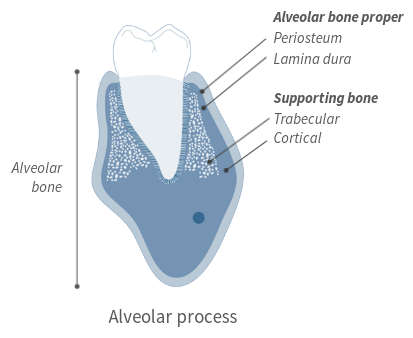The bone that supports teeth in the maxilla and mandible may be divided into two parts. As can be seen in this diagram of the mandible, the part that contains the roots of the teeth and developing tooth buds of unerupted teeth is known as the alveolar process, or alveolar bone. The bone of the alveolar process is continuous with the second part, the basal bone of the jaws, with no distinct boundary dividing them. The alveolar process is also made of two parts, the alveolar bone proper and the supporting bone. The bone lining the socket of a tooth is referred to as the alveolar bone proper. The rest of the bone that supports the teeth is the supporting bone.
Anatomical features of the alveolar process
author: Nikos Mardas | publisher: drg. Andreas Tjandra, Sp. Perio, FISID

The bone that supports teeth in the maxilla and mandible may be divided into two parts. As can be seen in this diagram of the mandible, the part that contains the roots of the teeth and developing tooth buds of unerupted teeth is known as the alveolar process, or alveolar bone. The bone of the alveolar process is continuous with the second part, the basal bone of the jaws, with no distinct boundary dividing them. The alveolar process is also made of two parts, the alveolar bone proper and the supporting bone. The bone lining the socket of a tooth is referred to as the alveolar bone proper. The rest of the bone that supports the teeth is the supporting bone.
Serial posts:
- Healing extraction socket
- Resorption modifies alveolar ridges
- Anatomical features of the alveolar process
- Forming alveolar ridge
- Alveolar process: function and development
- Parts of alveolar process
- Different terms for the alveolar bone proper
- Lamina dura
- Alveolar bone proper: Attachment apparatus
- Bundle bone
- Alveolar bone proper
- Supporting bone
- Outer cortical plate
- Cortical bone
- Trabecular bone
- Macroanatomy of alveolar process
- Extraction socket
- Extraction socket wall
- Alveolar ridge
- Ridge of edentulous site